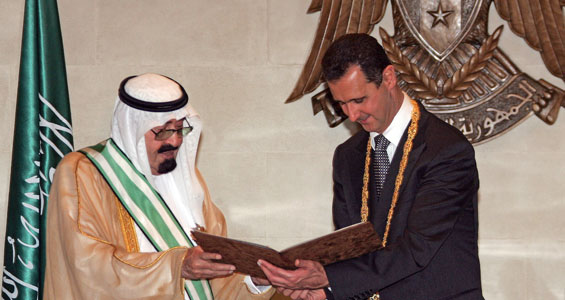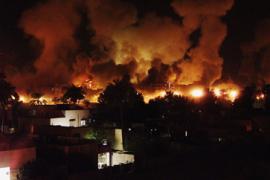Syria’s daring brinkmanship
Damascus avoided conflict with the West and won back regional influence, says analyst.

 |
| Al-Assad, right, presented the Saudi king with the Umayyad Order – the highest national honour medal in Syria – as a sign of much improved relations between their countries [EPA] |
The visit to Damascus of King Abdullah, the Saudi monarch, is perhaps the best news Syria has received in recent years. It comes as the crowning culmination of high-level meetings in Kuwait earlier this year and a visit by Bashar al-Assad, the Syrian president, to Riyadh in September.
For Damascus, such a high-level visit from a leader of a regional powerhouse marks a victory for its political brinkmanship and is an acknowledgement that Syria has matured into an indispensable player in the divided Arab World.
Syrian foreign policy has been basted on two pivotal principles: first, that there are no permanent enemies and no permanent friends; and second, that every situation can and will be used as leverage that will serve national interests and ensure the survivability of the regime.
Such a two-pronged approach is pragmatic when it calculates winnings and losses, and elastic when it absorbs any situation and attempts to turn it to its advantage.
For example, Syria saw no apparent conflict with its declared slogans of “Arab unity” and “Arab brotherhood” when it joined the US in its “war on terror” in 2003 and surrendered several Iraqi leaders who took refuge in its territories in the aftermath of the US invasion of Iraq.
Syria also endorsed the 2002 Saudi-brokered Arab Peace Initiative to normalise relations with Tel Aviv and even held bilateral talks with Israel with Turkish mediation.
Emerging from isolation
Turkey’s role in bringing Syria to the negotiating table should not be underestimated.
It was through Turkey – which is a US ally, Nato member and maintains diplomatic relations with Israel – that Syria managed to break its regional isolation, imposed by “moderate Arab states” as a punitive measure in the wake of the assassination of Rafiq al-Hariri, the former Lebanese premier, and for its support for Hezbollah.
Syria has persistently denied involvement in al-Hariri’s death.
Despite its talks with the Israelis, US envoys and attempts to seal intra-Arab differences, Syria maintained its diplomatic elasticity by continuing support for Hezbollah – its most important ally in the region.
Working on two parallels, Syria cultivates the legitimacy it has earned through association with Hezbollah’s resistance mantra. It also realises that its ties with the Shia Lebanese movement could be used as leverage in any future Middle East talks.
In exchange for logistical and political support from Damascus, Hezbollah maintains Syrian interests in Lebanon and in the region.
By its very nature a non-state actor, Hezbollah also possesses the liberty to provoke Israel without the fear of territorial or diplomatic repercussions that a state may face.
In peace time, Hezbollah provides diplomatic and military leverage against Israel, which in turn strengthens Syria’s position at any prospective negotiating table.
In this sense, Hezbollah serves as Syria’s first line of defence should Israel pursue military action, as it did in 2006.
But Hezbollah’s umbilical cord is ultimately tied to Tehran and this places the Hezbollah-Syrian relationship as part of a bigger strategic alliance with Iran.
Bush’s strategy
 |
| Assad did not want Damascus to suffer the same fate as Baghdad in 2003 [GETTY] |
It is no coincidence that Syria was considered the next stage of the Bush administration’s redrawing of the Middle East map; Iraq, followed by Syria and then, possibly Iran.
Immediately after the fall of Baghdad in April 2003, Washington considered implementing regime change in Damascus as part of the Bush administration’s policy of pre-emption.
Damascus observed with alarm as US officials alleged that Iraq’s “nuclear material” was hidden on Syrian territory and the rhetoric against Bashar al-Assad, the Syrian president, became more venomous.
By 2004, as the insurgency in Iraq took root, US commanders accused Syria of hosting Baathist leaders and arming militia leaders.
Realising that its survival was at stake, Syria – in tandem with Iran – supported the insurgency in Iraq despite US sabre-rattling.
This Syrian-Iranian strategy was designed to keep US forces bogged down in the Iraqi quagmire to prevent the US military from pointing their guns at them. It worked.
But it was the assassination of al-Hariri in February 2005 that turned the tide overwhelmingly against Syria. The US mobilised quickly to point fingers at Damascus for direct involvement in the plot and pushed for a UN Security Council resolution which established an investigation and tribunal to try the perpetrators.
This provided Washington with an opportunity to force – militarily if need be – Syrian troops out of Lebanon and push for removing the Assad government.
Outmanoeuvring Washington
 |
| Syria quickly withdrew its forces from Lebanon in the face of US threats [EPA] |
Sensing grave and mortal danger the Syrians outsmarted the Americans and quickly caved in.
They withdrew their troops from Lebanon fending off an emboldened and vociferous Lebanese opposition that accused Syria of assassinating Hariri while at the same time appeasing Washington’s forceful demands to exit from Lebanon.
This was a crucial move for the Syrians, and in fact a master stroke. By heeding the US “ultimatum” in withdrawing their troops, the Syrian leadership was able to avoid the fate Saddam Hussein met when he invaded Kuwait in 1990 and refused to withdraw his forces until it was too late.
Syria also managed, by sleight of hand, to strengthen its influence in Lebanon through its local allies and proxies, chiefly Hezbollah. In so doing, Syria actually managed to exit Lebanon through the door and come back through the window without having to pay a hefty price.
This pragmatism enabled the Syrian leadership to survive the possibility of regime change after the fall of Saddam Hussein, endure under US sanctions and erode the efficacy of the UN’s Hariri tribunal.
Arab rapprochement
The importance of King Abdullah’s visit to Damascus should not be underplayed. In 2006, Washington’s “moderate” allies – including Saudi Arabia – joined Western ranks in mounting concentrated pressure on the Syrians.
Yet, four years later, international and regional conditions have changed in such a way that turned in Syria’s advantage.
After Israel failed to eliminate Hezbollah as a viable threat in its war in 2006 – and following “regime change” in Washington with the Obama administration in the White House – Syria was able transform the Saudi-backed Hariri tribunal into a side show that is more like a nuisance than a real threat.
Moreover, Saudi Arabia, and to a certain extent Egypt, reached the realisation that the new Obama administration in Washington no longer considers Syria as an obstacle to its plans in the region but rather a possible partner when the time is ripe to sit at the bargaining table.
With this in mind, the Saudis, in reassessing their strategic interests in the region, realised that it is futile to continue alienating Syria which holds keys to Lebanon’s stability, Palestinian reconciliation, Iraq’s security and is an ally of the Saudi nemesis, Iran.
Ali Younes is a Washington-based Middle East analyst.
The views expressed in this article are the author’s own and do not necessarily reflect Al Jazeera’s editorial policy.